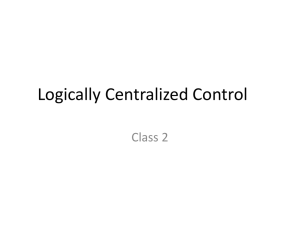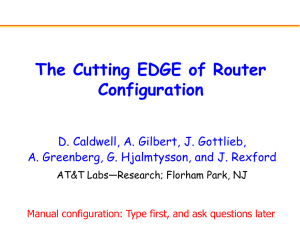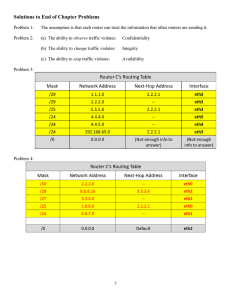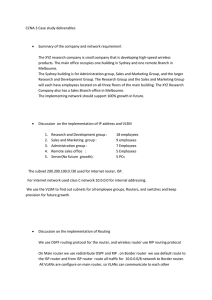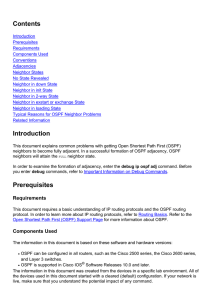The Cutting EDGE of Router Configuration D. Caldwell, A. Gilbert, J. Gottlieb,
advertisement
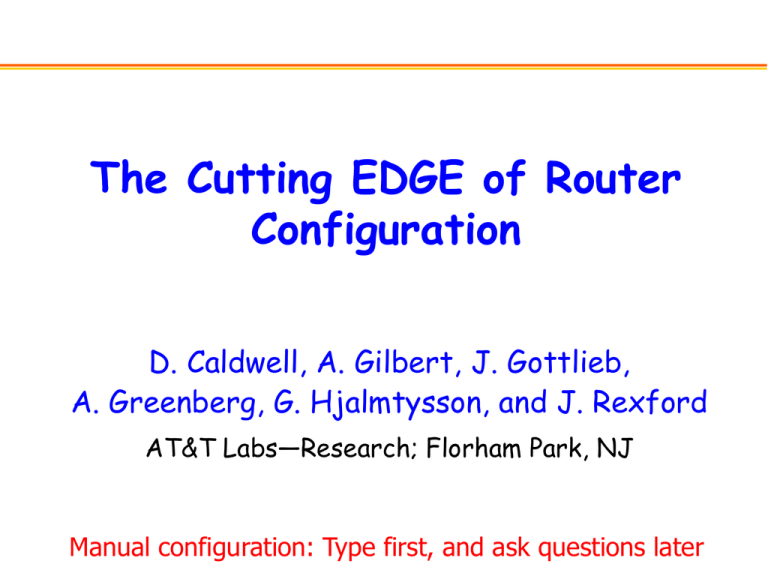
The Cutting EDGE of Router Configuration D. Caldwell, A. Gilbert, J. Gottlieb, A. Greenberg, G. Hjalmtysson, and J. Rexford AT&T Labs—Research; Florham Park, NJ Manual configuration: Type first, and ask questions later Manual Configuration • Dangerous – Typo in routing policy: black hole – Wrong OSPF area: no traffic on link – Missing packet filter: DoS vulnerability • Expensive – Delays in deploying equipment – Hiring & training skilled engineers – Lock-in to the router vendor • Disruptive – Half of network outages (Yankee Group) – BGP routing anomalies (SIGCOMM’02) – Failures of Internet services (USITS’03) Why is the Situation So Bad? • Networking field: emphasis on speed & features – Not manageability and simplicity – Constant change, without revisiting the design – Oodles of complex protocols and tunable parameters • Router vendors: lack of abstraction – Assembly language commands – Element-level configuration – Low-level mechanisms, not intent • Network administrators: melting under complexity – Learning on the job – Struggling just to keep up – The path to automation is overwhelming What’s a Networking Researcher to Do? • Myth: Only large service providers care. – Large enterprise networks care, big time – Other network’s problems affect the user • Myth: No research lives here. – The state-of-the-art is really pitiful (please help!) – Config languages, protocol modeling, data mining, … • Myth: I can’t play without special access. – Router testbeds, protocol modeling, simplicity, etc. – Get data from your campus/regional administrator • Myth: Campus/regional networks are too easy. – Maybe it is harder than we think… – If easy, please scale this simplicity to larger networks! Our Goal: Automated Configuration Technical Questions (TQ) What is your AS number? What export policy do you want? Do you want a dynamic default? What are your address blocks? Do you need to receive communities? DB interface <name> description <cust name> ip address <addr> <mask> ip access-group <acl> in ! router bgp 7018 neighbor <ip> remote-as <asn> neighbor <ip> route-map CUST-FACE in neighbor <ip> route-map <outmap> out neighbor <ip> distribute-list <racl> in neighbor <ip> soft-reconfiguration-inbound [neighbor <ip> send-community] ! query R U L E S interface Serial10/1/0/12:0 description CBB Customer ip address 12.7.35.1 255.255.255.252 ip access-group 666 in ! router bgp 7018 neighbor 12.7.35.2 remote-as 18585 neighbor 12.7.35.2 route-map CUST-FACE in neighbor 12.7.35.2 route-map FULL-ROUTES out neighbor 12.7.35.2 distribute-list 13 in neighbor 12.7.35.2 soft-reconfiguration-inbound ! router configlet template • How to transition an existing network? • How to get value as you move from here to there? • Our approach: detailed analysis of configuration data Lowering Barrier-to-Automation for Enterprises • Large enterprise networks – – – – Large stand-alone data networks Retail, financial, health, business, etc. Heterogeneity due to mergers and acquisitions Stringent reliability and performance demands Today EDGE Inventory database Existing network The network is the database Mistakes and inconsistencies Extracted from the configuration files Discord reports from analyzing config files Local config rules Poor (or no) Reverse-engineered by documentation, data mining on the policy violations configuration files Enablement and Debugging of Growing Enterprises Web reports Automation BOTTOM-UP APPROACH 1. Inventory database queries Abstract network database Extract summary information Bootstrap the database Report errors & warnings Allows immediate fixes Reverse-engineer policies Aids in fixing inconsistencies Explicitly enforce the rules Avoid future config mistakes 2. Fixing config mistakes 3. Codifying local policies Low level standard Discords form (tables) fix 4. Automated configuration polled Router configuration Runs on many thousands of configs a day. Bootstrapping the Inventory Database • Extracting summaries – – – – Routers & interfaces Routing protocols IP address usage Configuration commands • Network visualization – Routers and links – Attributes (capacity, routing parameters) – Layout (spring model) – Graph compression – Geographical info Dual hub-and-spoke Pinpointing Configuration Mistakes • Referential integrity – Multiple interfaces with same IP address – Items used but not defined, and vice versa • Packet/route filters, route-maps, QoS policy,… • Routing protocol (e.g., OSPF) – Local integrity checks (warnings) • Network statement matches no interfaces • Interface enabled in OSPF has no cost metric • Interface not enabled in OSPF has a cost metric – Correct adjacencies (errors) • OSPF interface is not part of a complete link • Remote end of link does not participate in OSPF • Interfaces on same link have different OSPF areas Example: Joining Parts of OSPF Config Together hostname MyRouter Remote end is in 12.123.36.72/30 ! interface POS7/0 ip address 12.123.36.74 255.255.255.252 ip ospf cost 50 ! Interface participates in OSPF router ospf 2 network 12.123.36.0 255.255.255.0 area 9 passive-interface Serial2/1/0/3.1 ! Example: Remote End in Different OSPF Area Extracted tables interface link OSPF network OSPF passive interface OSPF interface Intermediate tables active OSPF interface Simple SQL queries OSPF link with area mismatch Presentation query result Using Data Mining to Infer Local Policies • Pattern matching across routers – Equivalence: same configuration, same names – Synonym: same configuration, different names – Homonym: same name, different configuration • Infer rules and report exceptions – – – – “Finger daemon disabled” “Edge interfaces have inbound packet filters” “OSPF costs of 100 to hub1 and 200 to hub2” “IPX interfaces have SAP encapsulation” • Identifying “use cases” – Initial base configuration of each router – “Diffs” over time and across related routers – Common cases (e.g., adding link, new BGP session) Conclusion • Moving beyond manual configuration – Manual configuration is bad • Error-prone, expensive, and disruptive – Migrating to automation is hard • No inventory DB, buggy network, and poor docs – EDGE supports migration to automation • Bootstrap DB, report discords, and infer policies • More innovation is needed – – – – Better router configuration languages Protocol modeling and best common practices Data mining on existing data networks Autoconfigurable protocols and mechanisms
